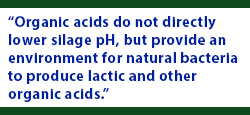
Bacterial inoculant or organic acid: Which is best for forages?
 By Eugene Rodberg, Kemin product manager
By Eugene Rodberg, Kemin product manager
When should we use an acid and when should we use a bacterial inoculant?
This question is not easy to answer because the answer changes from day to day. To understand when to best use these products, we need to understand why we use these products.
Bacterial inoculants
For decades, producers have used bacterial silage inoculants to enhance silage fermentation. Regardless of the strains, the role of bacterial inoculants is to grow and produce acid. Growing crops contain naturally occurring bacteria which, in the oxygen-free environment of well-packed silage, produce lactic and other organic acids. Vita Plus Crop-N-Rich® forage inoculants add more beneficial bacteria to silages, increasing lactic and/or acetic acid production. Silage inoculant bacteria typically grow best in a narrow moisture range. Growth of these beneficial bacteria is reduced in silages that are too wet or too dry.
 Acid preservatives
Acid preservatives
Organic acid preservatives are designed to assist in the fermentation of silages by providing an optimal environment for lactic acid-producing bacteria to grow. They do this by reducing non-beneficial mold and wild yeast populations that compete with lactic acid-producing bacteria. Organic acids do not directly lower silage pH, but provide an environment for natural bacteria to produce lactic and other organic acids.
When to use inoculants versus organic acids?
With a better understanding of the mode of action of each forage preservation tool, we can more easily identify when to use the correct product.
When conditions are ideal:
- Silage inoculants help silages produce more acid at a lower price and result in a more complete fermentation. Lactic acid-producing bacteria are extremely efficient.
- When corn silage moisture is between 60% and 70%, inoculants are an excellent choice to ensure proper silage preservation. For small grain silage, aim for an ideal moisture of 55% to 65% and 50% to 60% for alfalfa haylage.
When conditions are NOT ideal:
- Acid preservatives are recommended when corn silage moisture is outside the range of 60% to 70% and an inoculant is more likely to fail.
- An inoculant may not grow and produce the desired effect, which means it produces less acid than bacteria growing under ideal conditions.
What are conditions that impact ideal inoculant growth and favor acid usage?
- Moisture: The greater the deviation from ideal moisture, the more likely the inoculant will NOT multiply as expected. Low-moisture forage is a common reason for failure of an inoculant. On the other extreme, forage which is too wet will favor non-beneficial bacteria, allowing them to out-compete the inoculant.
- Glucose: Soluble carbohydrates are required to support inoculant growth. This is usually not an issue with corn. However, with small grain silage and alfalfa haylage, lack of soluble nutrients can limit growth of inoculants.
- Contamination: Excessive rainfall can lead to mold growth in the field. Silage made with a high mold count can out-compete the inoculant and can result in poor fermentation.
- Temperature: Most inoculants are sensitive to temperature – too cold and they grow slowly, too hot and they grow slowly or die. Besides air temperature, heating of the feed early in the ensiling process may also affect inoculant growth.
Organic acids and inoculants are both excellent tools available to help improve forage fermentation. Once we understand the mode of action of each of these two tools, we can use each product to our advantage to maximize the quality of our forage, no matter the conditions.
| Category: |
Feed quality and nutrition Forage Foundations Forage inoculants Silages |

